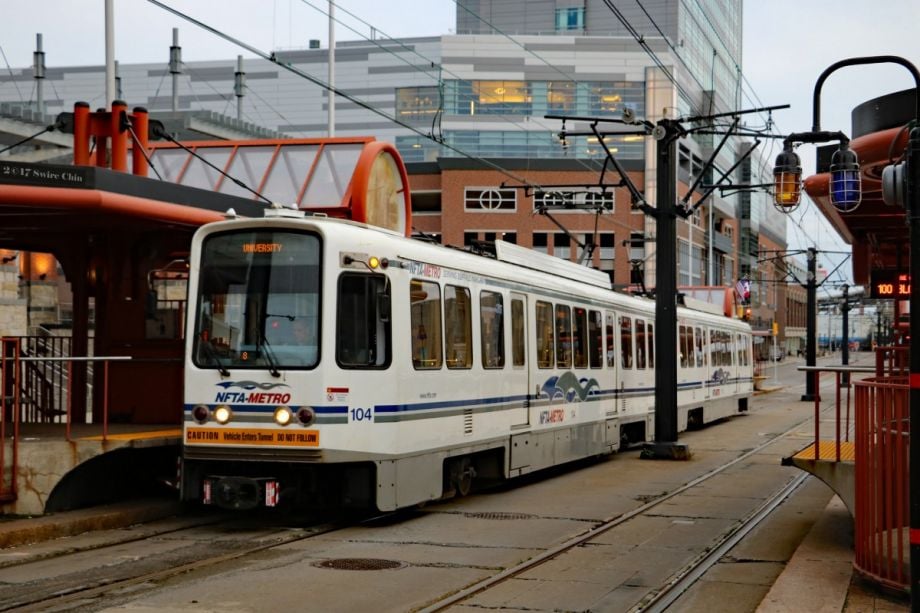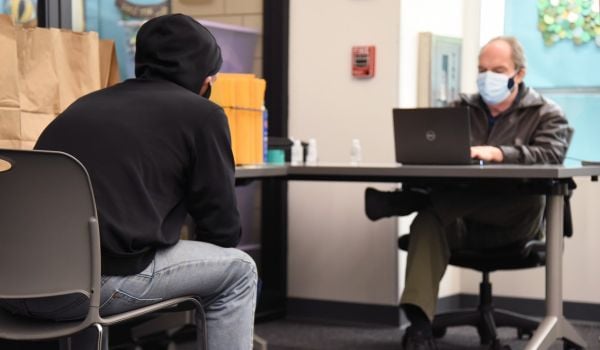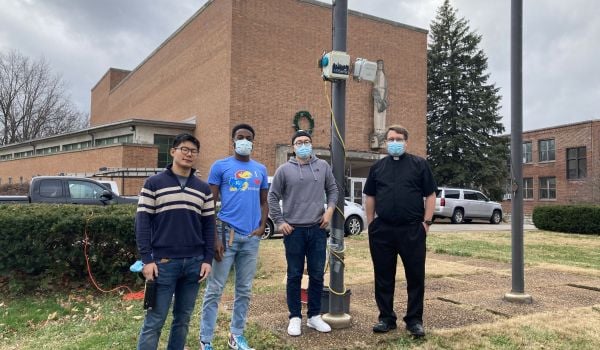Welcome to “The Mobile City,” our weekly roundup of newsworthy transportation developments.
Buffalo Transit Advocates Fight Feds Over Rail Transit Expansion
The city of Buffalo has the second-oldest of the country’s modern light rail transit lines: the NFTA Metro, a single light metro line opened in 1984 that oddly runs on the surface downtown and in a subway tunnel in the outlying neighborhoods.
When Buffalo drew up plans for rail transit in the 1970s, the current line was envisioned as the first segment of a multi-route system that would extend further into the city’s suburbs as well as southward from downtown. Funding issues have so far prevented anything other than a short extension to the University at Buffalo South Campus to be built, but local transit advocates have not given up on their goal of seeing the full system built.
Now, however, WBFO Radio reports that Citizens for Regional Transit (CRT), the advocacy group that has pursued that vision of rail transit for Buffalo since the initial line opened, finds itself fighting a new foe: the Federal Transit Administration (FTA).
While CRT and the Niagara Frontier Transportation Authority are ready to extend the light metro further north, to the suburb of Amherst, and northeast to the Buffalo Niagara International Airport in Cheektowaga, the FTA has suggested the agency consider buses instead.
This recommendation doesn’t sit well with CRT, which is pushing for the Cheektowaga line as a way to improve conditions in some of the city’s poorest neighborhoods, through which it will pass.
CRT president Douglas Funke says the FTA’s recommendation will leave the poor at a disadvantage. “What that says is that people who can afford a car can have a one-seat ride. Anyone who can’t afford a car is stuck, having to do a transfer halfway through their trip. That will be very difficult because the light rail can carry hundreds of people, while the buses are carrying 50. So you are going to have bottlenecks getting off the light rail and getting on the bus,” Funke told WBFO.
He is also urging local transit supporters and officials to push back against the FTA’s recommendation and conduct a full study of rail transit for Buffalo’s east side.
He also cast the current state of transit service in Buffalo in equity terms: “Because we haven’t invested in our public transportation, it isn’t very good,” he said. “NFTA does a good job with the budget they’ve got. Buses are running every 20 minutes. They are stuck in traffic. That’s not like high-speed light rail. People who are left taking public transit are poor people. They don’t have any political clout and they are easy to ignore.”
St. Louis Regional Planning Agency Rejects Funding Plan for Loop Trolley
The Loop Trolley, which connects Forest Park with the Delmar Loop business and entertainment district in the St. Louis suburb of University City, has lain dormant since 2019, when it shut down after a little more than a year of service due to low ridership. This has created a problem for the East-West Gateway Metropolitan Planning Organization (MPO) and the Loop Trolley Transportation Development District, which could find themselves on the hook for about $25 million in federal funding used to build the line if service is not restored.
A previous effort to restore service died in 2020 after Bi-State Development, which runs the St. Louis metropolitan transit system, rejected a proposal to have it take over the line completely. Now, St. Louis Public Radio reports, a second effort has met a similar fate: The MPO’s governing body, the East-West Gateway Council of Governments, voted to reject a plan to revive service using $1.26 million in federal funds along with a sales tax at businesses along the route that would raise $540,000 annually.
The proposal also called for Bi-State to oversee the operation of the trolley, a move that concerned St. Clair County, Ill., board chair Mark Kern, who told his fellow council members, “From all appearances, it’s going to be a loser.”
But at least one member of the council did favor the plan: St. Louis Mayor Tishuara Jones, who nonetheless said, “This project should have never been built.” Her concern, shared by Bi-State Development President and Chief Executive Officer Taulby Roach, was that defaulting on the federal grants already awarded to the line — $34 million of the $52 million that has been spent on the line to date — would jeopardize metropolitan St. Louis’ ability to compete for and receive future federal funds.
Think Tank Calls for Breaking NJ Transit Into Two Pieces
A handful of states, mostly geographically small and located in the Northeast, have their state transportation departments operate local mass transit service directly. And only three of them — Delaware, New Jersey and Rhode Island — have a single entity operating local transit service statewide.
Of those, the largest is New Jersey, where the New Jersey Transit Corporation (NJ Transit) operates the nation’s third-largest mass transit system. Now, the Philly Voice reports, a free-market-oriented think tank has come out with a paper that argues that this deal favors the state’s more populous northern half over its southern one and fails to meet the latter’s needs.
The Garden State Initiative (GSI) recommends that to fix this, NJ Transit be split in two.
In its report “The Road to Equitable Transportation Policies in New Jersey” (PDF), authors Jonathan Peters of CUNY College of Staten Island and Cameron Gordon of the Australian National University found, among other things, that the current system of putting fuel taxes and tolls into a single Transportation Trust Fund and allowing the governor to determine how much of the fund goes to NJ Transit each year shortchanges South Jerseyans, who have less robust transit service and drive more than North Jerseyans. In addition, because NJ Transit focuses more on its extensive rail transit network in the north, South Jersey doesn’t get the improved bus service needed to serve changing populations.
GSI also notes that more rural South Jersey will require more driving. “No matter what mass transit improvements there may be for South Jersey in the decades ahead, that region of the state will always be dependent on cars for basic travel,” GSI states. “Since South Jersey is often an afterthought in state mass transit planning and financing, the region deserves independent standing with its own dedicated state mass transit agency.”
The report also recommends dedicated revenue sources to fund mass transit statewide and offers a list of options.
Some Washington Metro Cars Return to Service
The space crunch on the Washington Metro should ease a bit with the return of seven Metrorail trains to service Nov. 1, Mass Transit reports.
The seven additional trains will allow Silver Line service to operate along its entire route. Red Line trains will operate every 15 to 20 minutes, Green Line trains every 20, and trains on all other lines will run every 30 to 40 minutes.
The additional trains consist of older Metrorail cars pulled out of storage and 6000-series units that had been sidelined to deal with safety issues but have been fixed.
The additional trains bring the total number of sets in service to 39. The Washington Metropolitan Area Transit Authority (WMATA) says it is working to get 50 trains in service as soon as it can.
Prior to the removal of the 748 7000-series cars in the wake of the Oct. 12 derailment, WMATA had enough cars to run up to 214 six-car trains. In 2012, before the Silver Line opened, 129 trains were required for peak-hour service on the nation’s second-busiest subway.
Know of a development that should be featured in this column? Send a Tweet with links to @MarketStEl using the hashtag #mobilecity.

Next City contributor Sandy Smith is the home and real estate editor at Philadelphia magazine. Over the years, his work has appeared in Hidden City Philadelphia, the Philadelphia Inquirer and other local and regional publications. His interest in cities stretches back to his youth in Kansas City, and his career in journalism and media relations extends back that far as well.
Follow Sandy .(JavaScript must be enabled to view this email address)


_600_350_80_s_c1.jpg)













